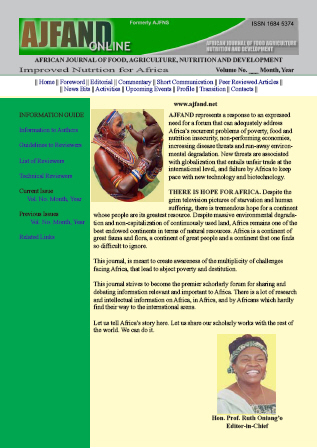
|
African Journal of Food, Agriculture, Nutrition and Development
Rural Outreach Program
ISSN: 1684-5358
EISSN: 1684-5358
Vol. 10, No. 9, 2010, pp. 3065-3079
|
 Bioline Code: nd10090
Bioline Code: nd10090
Full paper language: English
Document type: Research Article
Document available free of charge
|
|
|
African Journal of Food, Agriculture, Nutrition and Development, Vol. 10, No. 9, 2010, pp. 3065-3079
| en |
A competitive enzyme linked immunosorbent assay for the determination of diminazene residues in animal tissues
Karanja, W. M.; Mdachi, R. E.; Ngeranwa, J. N. & Murungi, J. I.
Abstract
The importance of ensuring food safety through the reduction of chemical residues in our food supply cannot be overemphasized. Food safety remains a major challenge confronting contemporary society. To ensure wholesomeness of food of animal origin, the level of drug residues must be below the maximum residue limits (MRLs) set by World Health Organization (WHO) and Food and Agriculture Organization (FAO). This calls for cost effective and efficient analytical methods for both quality assurance and monitoring. Diminazene aceturate is one of the few treatment drugs for animal trypanosomosis in the market. Because of its wide use in food producing animals, unwanted residues may be a risk to consumers. A competitive enzyme-linked immunosorbent assay (cELISA) for determination of diminazene residues in edible animal tissues after extraction in 0.1 M borax pH 9.7 is described. The assay has advantages of speed, high throughput and lower cost of analysis compared to the other conventional methods. The assay uses rabbit anti-diminazene polyclonal antibodies bound on a 96-well microtiter plate. Horseradish peroxidase-labeled diminazene and diminazene in a test sample were allowed to compete overnight at 4° C for the limited number of antibodies bound on the microtiter plate. After six washes with buffer, enzyme activity was determined by adding tetramethyl-benzidine and hydrogen peroxide as substrate. The assay detection limits for diminazene were 2.4 ng/g in muscle, 2.5 ng/g in liver and 2.2 ng/g in kidney while limits of quantification were 7.2 ng/g, 7.5 ng/g and 6.6 ng/g respectively. The recoveries for muscle liver and kidney spiked with 5 ng/g were 78%, 77% and 80% respectively while for 1,000 ng/g were 74%, 76.% and 84% respectively. The within-and between assay coefficients of variation (CV) were 2.4% and 15.5% respectively while assay specificity was above 99.9%. It is concluded that as a result of the good recoveries, high specificity and repeatability, the method could be used in the determination and monitoring of diminazene residues in tissues. These activities aimed at ensuring the safety of food of animal origin could play a major role in enhancing consumer confidence in these products which are very essential for health.
Keywords
Diminazene, Residues, cELISA, Animal tissues, Trypanosomosis
|
| |
© Copyright 2010 African Journal of Food Agriculture, Nutrition and Development.
Alternative site location: http://www.ajfand.net/
|
|
